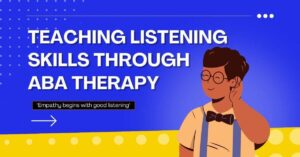
In the intricate web of human interaction, communication plays a pivotal role in connecting hearts and minds. For children with autism, however, this web can sometimes be challenging to navigate.
The good news is that Terapia de Análisis de Comportamiento Aplicado (ABA) offers a guiding light, paving the way to develop essential listening and communication skills in these young learners.
Let’s explore effective strategies that ABA therapy employs to empower children with autism to unlock their potential.
Understanding the Landscape: Autism and Communication
Autism Spectrum Disorder (ASD) is characterized by a range of difficulties in social interaction, communication, and repetitive behaviors. Many children with autism struggle with understanding nonverbal cues, expressing themselves, and maintaining back-and-forth conversations. This can lead to frustration, isolation, and hindered social development.
However, with the right interventions, these challenges can be addressed, enabling children with autism to thrive in their communication journey.
The ABA Approach: A Beacon of Hope
ABA therapy is a scientifically proven approach that focuses on understanding the unique underlying behaviors of the individual. By using a data-driven approach based on each child’s needs, ABA provides a structured framework to reinforce important skills through systematic interventions and lessons in the form of games and positive reinforcement.
Starting from just understanding single words, ABA teaches at the child’s pace using data-based decisions to guide the therapist where the child’s strengths and deficits are.
Key Strategies for Teaching Listening and Communication Skills
Functional Communication Training (FCT)
This strategy emphasizes teaching children alternative ways to communicate their needs and desires effectively. By identifying their motivations and preferences, therapists can help children express themselves using gestures, signs, pictures, or even augmentative communication devices.
For example, instead of getting upset when a child can’t reach for a toy, they learn to ask politely for help instead.
Enseñanza del Medio Natural (NET)
ABA therapists often create learning opportunities within the child’s natural environment. Through play and daily activities, therapists can teach listening and communication skills in real-life scenarios, helping children generalize these skills outside of therapy sessions.
An example of NET would be using a special interest of the child in play to teach a lesson. For instance, imagine you’re playing “cars” with a nonverbal child. You could make your car’s noise sound more interesting and have the child deliberately ask for the car – offering praise with the toy.
Verbal Behavior Therapy
This component of ABA therapy focuses on breaking down communication into smaller, manageable components. Children learn to associate words with their meanings by connecting words with their purposes. This approach enables them to understand and use language more effectively.
Verbal Behavior therapy does not focus on words as labels (cat, car, etc.). Instead, it teaches why we use words and how they are useful in making requests and communicating ideas.
Language is classified into types called “operants.” Each operant has a different function. Verbal Behavior therapy focuses on four-word types:
-
Mand: A request, such as saying “toy,” to ask for a toy
-
Tact: A comment used to share an experience or to draw attention to something, such as “airplane” to point out an airplane
-
Intraverbal: A word used to respond or answer a question, such as “Where do you go to school?” “Playground!”
-
Echoic: A repeated, or echoed, word, such as “toy?” “Toy!” This is important as imitating will help the student learn
Joint Attention Activities
Many children with autism struggle with joint attention – the ability to share an experience and maintain focus on it with someone else. An example being playing catch or a board game together.
ABA therapists engage children in activities that encourage them to focus on the same object or event, fostering the foundation for back-and-forth communication between themselves and others.
Social Stories and Visual Supports
Visual aids, such as social stories, visual schedules, and cue cards, provide children with autism the structure and predictability they need to navigate social interactions. These tools can help them understand the sequence of events, manage transitions, and comprehend social cues.
A prime example of a visual support for learning to listen and communicate could be a “talking stick” held by the person who is allowed to speak and then passed off to the next person for the turn to talk. This can make it easier for them to know when to listen and when to talk.
Peer-Mediated Interventions
Interacting with peers offers valuable learning opportunities. ABA therapy companies often incorporate peer play sessions to help children with autism practice communication in a comfortable and supportive environment.
Applied ABC offers something similar in our Social Skills Groups (SSG) activities and get-togethers across most of our service areas, with plans to expand group therapy opportunities in the future. If you’re interested in learning more or signing your child up with a local SSG, learn more here!
The Power of Consistency and Positive Reinforcement
ABA therapy places a strong emphasis on consistency and positive reinforcement. By rewarding children for good behavior with rewards that hold personal significance to the child, ABA therapy creates a motivational environment that encourages the development of skills.
Many young children, including those with autism, have a hard time understanding the difference between good and bad behavior. It’s key for parents to use praise to reinforce positive behaviors, like listening attentively. When you notice your child listening and responding to what you say, comment on it. Say things like “Great job for listening to me there” or “Thank you for responding when I said your name.”
Empowering Future Connections
Teaching listening and communication skills to children with autism is not just about helping them communicate their needs – it’s about empowering them to forge meaningful connections. ABA therapy equips these children with tools to navigate the intricacies of human interaction, fostering a sense of belonging and enhancing their overall quality of life.
As ABA therapy companies continue to refine their techniques, children with autism are increasingly able to transcend communication barriers and build bridges of understanding with the world around them. Through the dedication of therapists, the support of families, and the resilience of these young learners, the journey toward effective communication becomes a beacon of hope, illuminating a brighter future for all.
Fuentes citadas:
Henry, A., & Solari, E. Targeting Oral Language and Listening Comprehension Development for Students with Autism Spectrum Disorder: A School-Based Pilot Study






